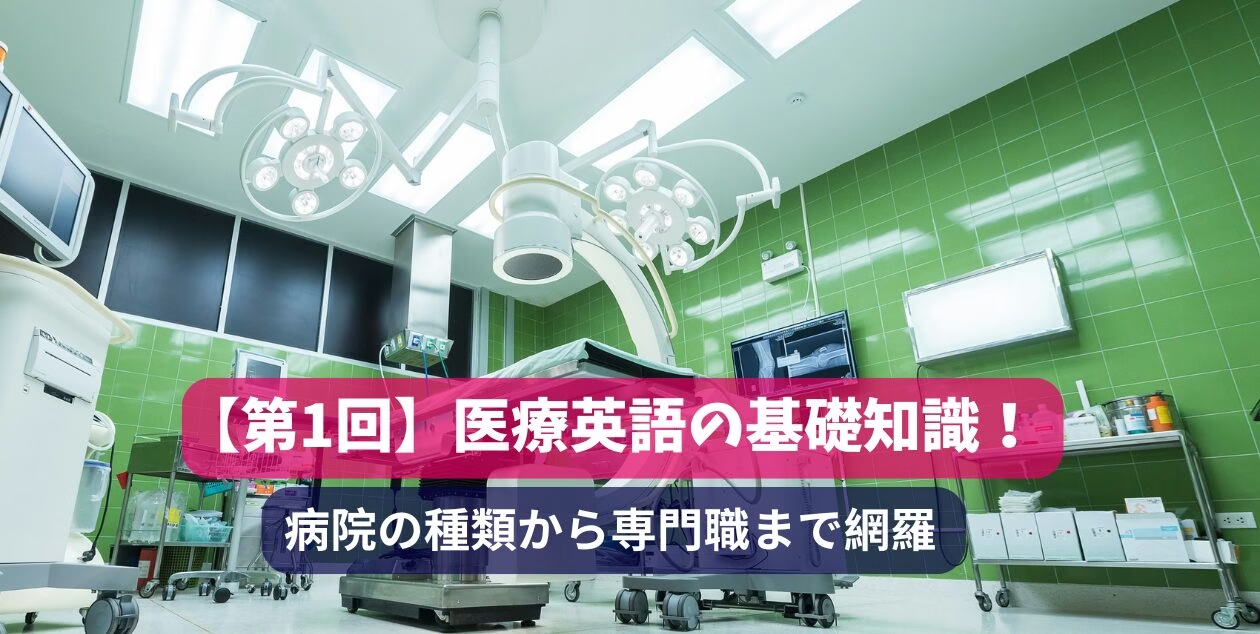海外での生活や旅行中、もし体調を崩して病院に行くことになったら、あなたは自信を持って症状を伝え、必要な医療サービスを受けられますか?見慣れない医療施設の種類、専門的な診療科や職種の名前、そして何よりも英語でのコミュニケーションに不安を感じる方は少なくないでしょう。
しかし、ご安心ください。このガイドでは、海外の医療現場で役立つ実践的な英語表現と知識を徹底解説します。病院やクリニックといった施設の種類から、内科や小児科といった主要な診療科、さらには医師、看護師、医療通訳といった多岐にわたる医療従事者の役割まで、よく使われる専門用語を具体的な例文とともにご紹介。
この記事を読み終える頃には、国際的な医療環境に対する理解が深まり、緊急時にも落ち着いて対応できる自信がつくはずです。患者さんご自身だけでなく、医療関係者や医療通訳を目指す方にとっても、きっと役立つ情報が満載です。
医療施設・医療機関の基本用語
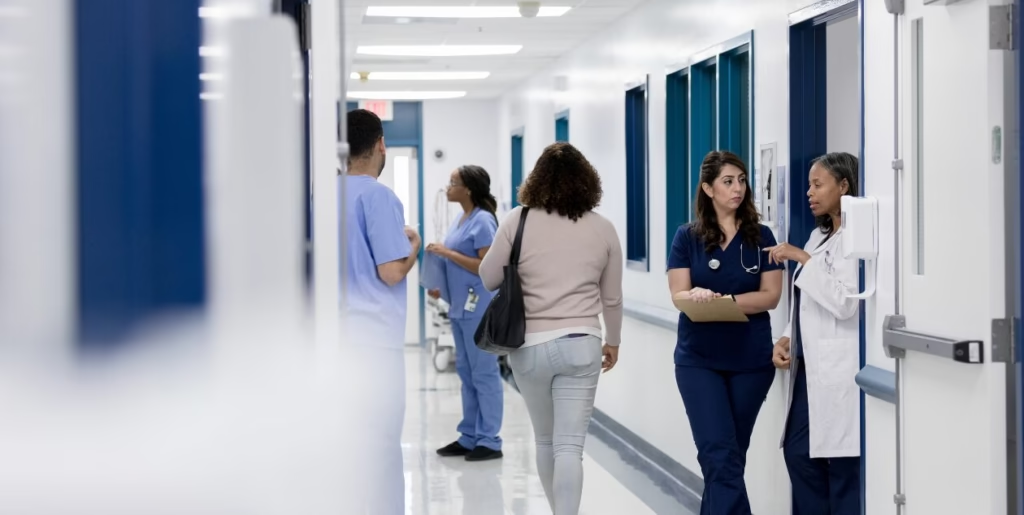
医療現場で最も基本となる施設や機関の名称から学んでいきましょう。これらの用語は日常的に使われるため、正確な発音と使い分けが重要です。
主要な医療施設
Hospital [ˈhɒspɪtl]
意味: 病院
解説: 総合的な医療・手術・入院を行う施設
例文: “He was taken to the hospital after the accident.”
和訳: 事故の後、彼は病院に運ばれた。
Clinic [ˈklɪnɪk]
意味: クリニック・診療所
解説: 主に外来診療を行い、入院設備が小規模またはない医療機関
例文: “She visits the clinic for her regular check-up.”
和訳: 彼女は定期健診のためクリニックに通っている。
Nursing Home [ˈnɜːrsɪŋ hoʊm]
意味: 介護施設・老人ホーム
解説: 医療・介護が必要な高齢者が入居する施設
例文: “My grandmother lives in a nursing home.”
和訳: 祖母は老人ホームに住んでいる。
Urgent Care Center [ˈɜːʤənt ker ˈsentər]
意味: 救急外来センター
解説: 急な病気や怪我を診断・治療する施設
例文: “He went to the urgent care center after cutting his hand.”
和訳: 彼は手を切ったあと救急外来センターに行った。
基本的な診療科
Emergency Department (ED) [ɪˈmɜːrdʒənsi dɪˈpɑːrtmənt]
意味: 救急科
解説: 急性疾患やケガの治療を担当
例文: “The patient was admitted to the emergency department.”
和訳: 患者は救急科に入院した。
Radiology [ˌreɪdiˈɒlədʒi]
意味: 放射線科
解説: 画像診断(レントゲン、CT、MRI等)を行う部門
例文: “Radiology is essential for accurate diagnosis.”
和訳: 放射線科は正確な診断に不可欠である。
内科系診療科の英語表現
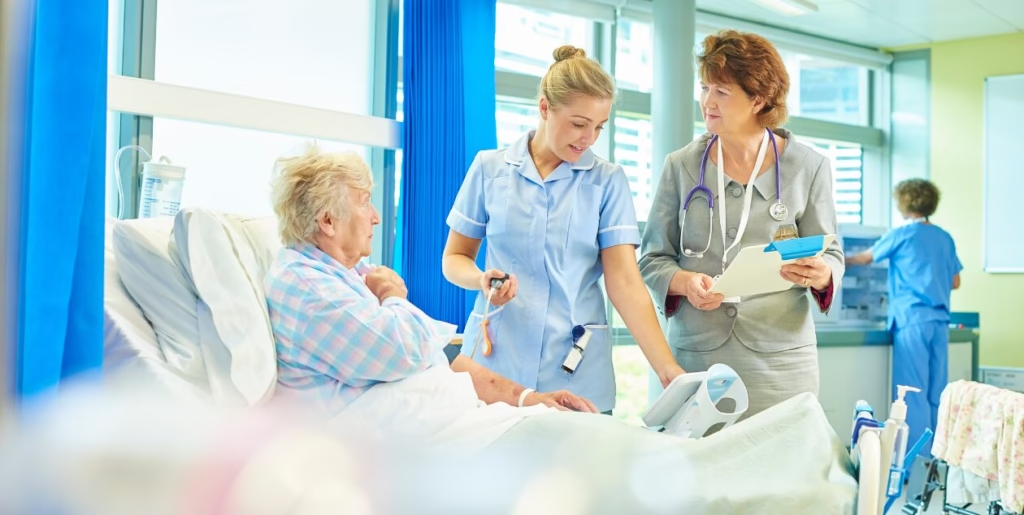
内科系診療科は医療現場で最も頻繁に使われる部門です。各科の特徴と専門分野を理解し、適切に使い分けることが重要です。
基本内科
Internal Medicine [ɪnˈtɜːrnəl ˈmɛdɪsən]
意味: 総合内科
解説: 成人を対象とする一般的な疾患(風邪、高血圧、糖尿病など)を総合的に診る基本的な診療科
例文: “She went to the internal medicine department for a check-up.”
和訳: 彼女は健康診断のために内科を受診した。
循環器・心臓系
Cardiology [ˌkɑːrdiˈɑːlədʒi]
意味: 循環器内科
解説: 心臓や血管の疾患(動悸、不整脈、狭心症、心筋梗塞など)を診療する科
例文: “He was referred to cardiology due to chest pain.”
和訳: 胸痛のため、彼は循環器内科を紹介された。
呼吸器系
Respiratory Medicine / Pulmonology [ˌrɛspəˈrətɔːri ˈmɛdɪsən / ˌpʌlməˈnɑːlədʒi]
意味: 呼吸器内科
解説: 肺炎、喘息、慢性閉塞性肺疾患(COPD)など、肺・気道の病気の診療科
例文: “She is being treated in the pulmonology department for asthma.”
和訳: 彼女は喘息の治療を呼吸器内科で受けている。
消化器系
Gastroenterology [ˌɡæstroʊˌɛntəˈrɑːlədʒi]
意味: 消化器内科
解説: 食道、胃、小腸、大腸、肝臓、膵臓などの消化器系疾患を専門とする科
例文: “He had a colonoscopy at the gastroenterology clinic.”
和訳: 彼は消化器内科で大腸内視鏡検査を受けた。
内分泌系
Endocrinology [ˌɛndəkrəˈnɑːlədʒi]
意味: 内分泌内科
解説: ホルモンに関する疾患(糖尿病、甲状腺疾患、下垂体疾患など)を扱う診療科
例文: “The patient was diagnosed with hyperthyroidism in endocrinology.”
和訳: 内分泌内科でその患者は甲状腺機能亢進症と診断された。
腎臓系
Nephrology [nɛˈfrɑːlədʒi]
意味: 腎臓内科
解説: 腎臓の病気(腎炎、腎不全、尿検査異常など)や透析治療を行う専門科
例文: “Nephrology is monitoring his kidney function.”
和訳: 腎臓内科が彼の腎機能を管理している。
血液系
Hematology [ˌhiːməˈtɑːlədʒi]
意味: 血液内科
解説: 貧血、白血病、リンパ腫など血液や造血器の病気を扱う
例文: “The hematology department confirmed a diagnosis of leukemia.”
和訳: 血液内科で白血病の診断が確定された。
感染症
Infectious Diseases [ɪnˈfɛkʃəs dɪˈziːzɪz]
意味: 感染症内科
解説: インフルエンザ、結核、COVID-19など感染症全般を診る
例文: “She was isolated in the infectious disease ward.”
和訳: 彼女は感染症病棟に隔離された。
リウマチ・自己免疫
Rheumatology [ˌruːməˈtɑːlədʒi]
意味: リウマチ科
解説: 関節リウマチ、膠原病、自己免疫疾患などを扱う
例文: “The rheumatologist prescribed medication for her arthritis.”
和訳: リウマチ科医が関節炎の薬を処方した。
外科系診療科の英語表現

外科系診療科は手術を中心とした治療を行う重要な部門です。各専門分野の特徴を理解し、適切に表現できるようになりましょう。
一般外科
General Surgery [ˈdʒɛnərəl ˈsɜːrdʒəri]
意味: 一般外科
解説: 外科全般に対応し、消化器、甲状腺、ヘルニアなどの日常的手術を行う
例文: “He underwent a hernia operation in general surgery.”
和訳: 彼は一般外科でヘルニアの手術を受けた。
脳神経外科
Neurosurgery [ˈnjʊəroʊˌsɜːrdʒəri]
意味: 脳神経外科
解説: 脳腫瘍、脳出血、脊髄疾患などを手術で治療する外科
例文: “The neurosurgeon removed the brain tumor.”
和訳: 脳神経外科医が脳腫瘍を摘出した。
整形外科
Orthopedic Surgery [ˌɔːrθəˈpiːdɪk ˈsɜːrdʒəri]
意味: 整形外科
解説: 骨折、関節疾患(変形性膝関節症など)、脊椎などの運動器系の診療
例文: “He had knee replacement surgery in orthopedics.”
和訳: 彼は整形外科で膝の人工関節手術を受けた。
形成外科
Plastic Surgery [ˈplæstɪk ˈsɜːrdʒəri]
意味: 形成外科
解説: 外傷や先天疾患後の再建手術、また美容整形も含む
例文: “Plastic surgery repaired the facial fractures.”
和訳: 顔の骨折を形成外科で修復した。
特殊診療科・専門科の英語表現
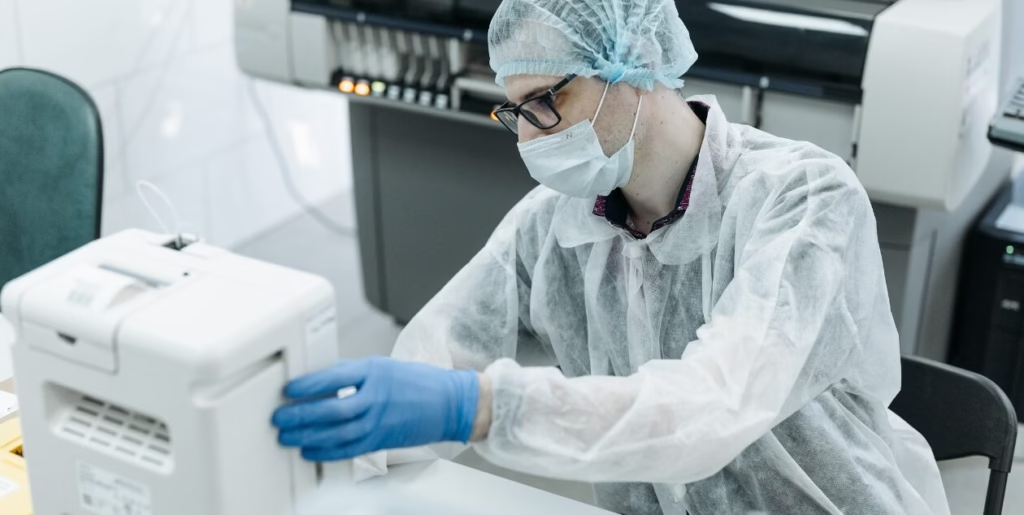
医療の専門化が進む中で、特殊診療科の重要性が高まっています。これらの診療科名を正確に表現できることは、専門的な医療コミュニケーションに不可欠です。
小児科
Pediatrics [ˌpiːdiˈætrɪks]
意味: 小児科
解説: 0~18歳までの子どもの病気・発達・予防接種などを広くカバー
例文: “She brought her son to pediatrics for a fever.”
和訳: 彼女は息子を発熱のため小児科に連れて行った。
産婦人科
Obstetrics and Gynecology (OB/GYN) [ɑbˈstɛtrɪks ənd ˌɡaɪnəˈkɑːlədʒi]
意味: 産婦人科
解説: 妊娠・出産・女性の生殖器疾患を扱う科
例文: “She’s seeing her OB/GYN for prenatal care.”
和訳: 彼女は妊婦検診のため産婦人科を受診している。
皮膚科
Dermatology [ˌdɜːrməˈtɑːlədʒi]
意味: 皮膚科
解説: ニキビ、水虫、皮膚炎、アレルギー症状など皮膚疾患全般
例文: “He consulted dermatology for a skin rash.”
和訳: 彼は皮膚のかゆみで皮膚科を受診した。
眼科
Ophthalmology [ˌɑːfθəˈmɑːlədʒi]
意味: 眼科
解説: 近視、白内障、緑内障、網膜疾患などの診療・手術
例文: “She had her vision checked in ophthalmology.”
和訳: 彼女は眼科で視力検査を受けた。
精神科
Psychiatry [saɪˈkaɪətri]
意味: 精神科
解説: うつ、不安、統合失調症、精神障害などの診療
例文: “He is taking medication prescribed by psychiatry.”
和訳: 彼は精神科から処方された薬を服用している。
救急診療科
Emergency Medicine [ɪˈmɜːrdʒənsi ˈmɛdɪsən]
意味: 救急診療科
解説: 急性疾患や事故・外傷などの初期対応を24時間担う診療部門
例文: “She was taken to emergency due to chest tightness.”
和訳: 胸の圧迫感で彼女は救急に搬送された。
麻酔科
Anesthesiology [ˌæn.əsˌθiː.ziˈɑː.lə.dʒi]
意味: 麻酔科
解説: 病気や手術などで苦痛や意識を軽減するための麻酔管理、および全身管理を担う診療科
例文: “He specializes in anesthesiology and manages patients during surgery.”
和訳: 彼は麻酔科を専門とし、手術中の患者を管理している。
腫瘍内科
Oncology [ɑːnˈkɑː.lə.dʒi]
意味: 腫瘍内科・がん内科
解説: がんの診断、治療(化学療法、免疫療法など)、経過観察を専門とする診療科
例文: “He was referred to oncology for further evaluation.”
和訳: 彼はさらなる検査のため腫瘍内科に紹介された。
放射線治療科
Radiation Oncology / Radiation Therapy [reɪ.diˈeɪ.ʃən ɒnˈkɒl.ə.dʒi / reɪ.diˈeɪ.ʃən ˌθer.ə.pi]
意味: 放射線治療科
解説: がんなど腫瘍性疾患に放射線を用いて治療を行う専門診療科
例文: “She is receiving treatment in the radiation oncology department.”
和訳: 彼女は放射線治療科で治療を受けている。
リハビリテーション科
Physical Medicine and Rehabilitation (PM&R) / Physiatry [ˌfɪz.ɪ.kəl ˈmed.ɪ.sən ænd ˌriː.həˌbɪ.lɪˈteɪ.ʃən / fɪˈzaɪ.ətri]
意味: リハビリテーション科(リハ科)
解説: 身体機能障害や慢性疾患、事故や手術後の機能回復、社会復帰を援助する診療科
例文: “Patients regain mobility through physical medicine and rehabilitation.”
和訳: 患者はリハビリテーション科によって移動機能を回復した。
病理診断科
Pathology [pəˈθɑː.lə.dʒi]
意味: 病理診断科
解説: 組織や細胞、体液(血液・尿など)を顕微鏡などで解析・診断し、病気の原因や進行度を特定する診療科
例文: “The diagnosis was confirmed in the pathology lab.”
和訳: 診断は病理診断科で確定された。
緩和ケア科
Palliative Medicine / Palliative Care [ˈpæli.ə.tɪv ˈmɛd.ɪ.sən / ˈpæli.ə.tɪv keər]
意味: 緩和ケア科
解説: がんなどの重篤な病気患者の症状緩和や精神的苦痛のケア、QOL(生活の質)の向上を目指す診療科
例文: “Palliative care focuses on improving quality of life for patients with serious illness.”
和訳: 緩和ケア科は重篤な病気の患者の生活の質向上に注力する。
集中治療科
Intensive Care Medicine / Critical Care Medicine [ɪnˌtensɪv keər ˈmɛd.ɪ.sən]
意味: 集中治療科
解説: 生命の危機にある重症患者の全身管理・人工呼吸器管理・救命治療などを専門とする診療科
例文: “He was admitted to the intensive care unit after surgery.”
和訳: 手術後、彼は集中治療室に入院した。
泌尿器科
Urology [jʊˈrɒl.ə.dʒi]
意味: 泌尿器科
解説: 腎臓、尿管、膀胱、尿道、および男性生殖器の疾患の診断・治療を行う診療科
例文: “The man visited urology for a urinary problem.”
和訳: その男性は泌尿器の問題で泌尿器科を受診した。
耳鼻咽喉科
Otorhinolaryngology (ENT) [ˌoʊ.toʊˌraɪ.noʊˌlær.ɪnˈɡɑːl.ə.dʒi]
意味: 耳鼻咽喉科
解説: 耳・鼻・喉(咽頭・喉頭)、口腔、頭頸部の疾患の診断・治療。一般的にENT(Ear, Nose, and Throat)とも呼ばれる
例文: “He was referred to ENT for chronic sinusitis.”
和訳: 彼は慢性副鼻腔炎で耳鼻咽喉科に紹介された。
その他の専門科
Allergy and Immunology [ˈæl.ɚ.dʒi ænd ɪˌmjuː.nəˈlɑː.lə.dʒi]
意味: アレルギー・免疫科
解説: アレルギー疾患(花粉症・食物/薬物アレルギー等)や免疫異常の診断・治療
例文: “She visited allergy and immunology for her hay fever.”
和訳: 彼女は花粉症でアレルギー科を受診した。
Geriatric Medicine [ˌdʒɛr.iˈæt.rɪk ˈmɛd.ɪ.sən]
意味: 老年科
解説: 高齢者の健康管理・慢性疾患・介護問題を総合的に診る診療科
例文: “Geriatric medicine helps manage chronic conditions in elderly patients.”
和訳: 老年科は高齢患者の慢性疾患管理を支援する。
Sports Medicine [spɔːrts ˈmɛd.ɪ.sən]
意味: スポーツ医学科
解説: アスリートやスポーツ愛好家のケガの治療・予防・リハビリを行う診療科
例文: “He visited sports medicine after a knee injury.”
和訳: 彼は膝のケガでスポーツ医学科を受診した。
Sleep Medicine [sliːp ˈmɛd.ɪ.sən]
意味: 睡眠医療科
解説: 睡眠障害(睡眠時無呼吸症候群、不眠症等)の診断・治療の専門科
例文: “She sought help from sleep medicine for her insomnia.”
和訳: 彼女は不眠症で睡眠医療科を受診した。
Occupational and Environmental Medicine [ˌɑː.kjəˈpeɪ.ʃə.nəl ænd ɪnˌvaɪ.rənˈmen.təl ˈmed.ɪ.sən]
意味: 産業・環境医学科
解説: 職場や環境に起因する健康障害の予防・診断・治療
例文: “He was referred to occupational medicine after a work injury.”
和訳: 彼は職場のケガで産業医学科に紹介された。
医療職種・関連職業の英語表現

医療現場では多様な専門職が連携して患者ケアを行います。各職種の役割と責任を理解し、適切に英語で表現できることは重要です。
医療従事者の基本職種
Doctor / Physician [ˈdɒktər / fɪˈzɪʃən]
意味: 医師
解説: 診断・治療・処方を行う主要な医療従事者
例文: “The doctor examined the patient’s chest.”
和訳: 医師は患者の胸部を診察した。
Nurse [nɜːrs]
意味: 看護師
解説: ケアや処置、医師のサポートを担当
例文: “Nurses monitor patients’ vital signs.”
和訳: 看護師は患者のバイタルサインを管理する。
Medical Assistant [ˈmɛdɪkəl əˈsɪstənt]
意味: 医療助手
解説: 外来での患者対応、事務や基本的な医療行為補助
例文: “The medical assistant helped schedule appointments.”
和訳: 医療助手が予約を手伝った。
Surgeon [ˈsɜːrdʒən]
意味: 外科医
解説: 手術を行う医師
例文: “The surgeon performed a successful operation.”
和訳: 外科医は手術を成功させた。
Chief Medical Officer [tʃiːf ˈmɛdɪkəl ˈɒfɪsər]
意味: 医療部長・最高医療責任者
解説: 医療機関の医療全般の責任者
例文: “She was appointed as the new Chief Medical Officer.”
和訳: 彼女は新しい医療部長に任命された。
上級医療職
Physician Assistant [fɪˈzɪʃ.ən əˈsɪs.tənt]
意味: 医師助手(PA)
解説: 医師の監督下で診断・治療・処方・小手術など幅広く医療業務を担う
例文: “The physician assistant examined the patient before the doctor.”
和訳: 医師助手が医師に先立ち患者を診察した。
Nurse Practitioner [nɜːrs prækˈtɪʃ.ən.ɚ]
意味: ナースプラクティショナー
解説: 高度な看護知識と診療能力を持つ上級看護師。医師業務の一部も担当
例文: “The nurse practitioner prescribed medication for the infection.”
和訳: ナースプラクティショナーが感染症の薬を処方した。
リハビリテーション関連職種
Physical Therapist [ˈfɪz.ɪ.kəl ˈθer.ə.pɪst]
意味: 理学療法士
解説: 怪我や障害からの運動機能回復・維持をサポート
例文: “The physical therapist designed an exercise program for her recovery.”
和訳: 理学療法士が彼女の回復のための運動プログラムを作成した。
Occupational Therapist [ˌɑː.kjəˈpeɪ.ʃə.nəl ˈθer.ə.pɪst]
意味: 作業療法士
解説: 日常生活動作・社会復帰・仕事復帰などの機能改善支援を行う
例文: “She worked with an occupational therapist after her stroke.”
和訳: 彼女は脳卒中後、作業療法士とリハビリを行った。
Speech-Language Pathologist [spiːtʃ ˈlæŋ.ɡwɪdʒ pəˈθɑː.lə.dʒɪst]
意味: 言語聴覚士
解説: 言語・発声・嚥下障害の診断・リハビリテーションを担当
例文: “A speech-language pathologist helped the child with pronunciation.”
和訳: 言語聴覚士が発音の訓練を子どもにした。
Respiratory Therapist [ˈrɛs.pə.rəˌtɔːr.i ˈθer.ə.pɪst]
意味: 呼吸療法士
解説: 呼吸管理・人工呼吸器調整・酸素療法を専門的に担当
例文: “The respiratory therapist set up the ventilator for the patient.”
和訳: 呼吸療法士が患者の人工呼吸器を調整した。
技術系専門職
Radiologic Technologist (Radiographer) [ˌreɪdiəˈlɑːdʒɪk tekˈnɒlədʒɪst]
意味: 診療放射線技師
解説: X線・CT・MRI等の画像検査を実施し診断をサポート
例文: “The radiologic technologist took an X-ray of the patient’s leg.”
和訳: 放射線技師が患者の足のX線を撮影した。
Clinical Laboratory Technologist [ˈklɪn.ɪ.kəl ˈlæb.rəˌtɔːr.i tekˈnɒlədʒɪst]
意味: 臨床検査技師
解説: 血液・尿などの検体検査を担当し、疾患診断の根拠を提供
例文: “A technologist analyzed blood samples in the laboratory.”
和訳: 技師が検査室で血液サンプルを分析した。
Medical Technologist [mɛdɪkəl tɛkˈnɒlədʒɪst]
意味: 臨床検査技師
解説: 各種検査(血液、尿、画像など)の実施
例文: Medical technologists analyze blood samples.””
和訳: 臨床検査技師は血液サンプルの分析を行う。
Social Worker [ ˈsoʊʃl ˈwɜːrkər]
意味: 医療ソーシャルワーカー
解説: 患者や家族の心理・社会的支援を提供
例文: “A social worker supported the patient’s family.”
和訳: ソーシャルワーカーが患者家族を支援した。
実践的な会話例

会話例 1:初診の受付で(患者と受付スタッフ)
Receptionist: Good morning. How can I help you today?
Patient: Good morning. I’d like to see a doctor because I’ve had chest pain since yesterday.
Receptionist: I see. We’ll refer you to Internal Medicine first, and if necessary, you may also visit Cardiology.
Patient: Okay, thank you. Do I need to fill out any forms?
Receptionist: Yes, please fill out this form and return it to the Health Information Manager at the counter.
受付スタッフ:おはようございます。本日はどのようなご用件でしょうか?
患者:おはようございます。昨日から胸が痛くて、診てもらいたいのですが。
受付スタッフ:かしこまりました。まずは内科(Internal Medicine)の受診となりますが、必要があれば循環器内科(Cardiology)にもお回りいただきます。
患者:わかりました。何か記入するものはありますか?
受付スタッフ:はい。こちらの用紙をご記入のうえ、窓口の診療情報管理士(Health Information Manager)へご提出ください。
会話例 2:診察室にて(患者と医師)
Doctor: Hello, I’m Dr. Williams from the Pulmonology department. What brings you in today?
Patient: I’ve been coughing a lot and I feel short of breath.
Doctor: I understand. Based on your symptoms, I’d like to order a chest X-ray, so you will go to Radiology first.
Patient: Is it painful?
Doctor: No, not at all. The Radiologic Technologist will explain everything and take care of the scan.
医師:こんにちは。私は呼吸器内科(Pulmonology)のウィリアムズ医師です。今日はどうされましたか?
患者:最近ずっと咳が出ていて、息苦しさも感じます。
医師:そうでしたか。症状から判断して、胸部X線を撮りましょう。まずは放射線科(Radiology)へ移動してください。
患者:それって痛いですか?
医師:いいえ、まったく痛みはありません。診療放射線技師(Radiologic Technologist)が丁寧にご説明し、撮影を行いますのでご安心ください。
会話例 3:検査中の通訳(医療通訳と外国人患者)
Medical Interpreter: Good afternoon. I’m your Medical Interpreter for today. Is it okay if I help you understand the examination process?
Patient: Yes, please. I don’t speak much English.
Radiologic Technologist: Please ask the patient to remove any metal items before the MRI.
Interpreter: The technologist says you need to remove all metal before the scan.
医療通訳:こんにちは。今日は私が医療通訳(Medical Interpreter)を担当します。検査の説明などをお手伝いしてもよろしいでしょうか?
患者:はい、お願いします。あまり英語がわからないので。
技師:患者さんに、MRIの前に金属類を外すように伝えてください。
通訳:技師の方が、撮影前に金属製品をすべて外すようにとのことです。
会話例 4:入院と退院の調整(ケースワーカーと患者)
Case Worker: Hello, I’m a Medical Social Worker here at the hospital. I’ll help you with your discharge planning.
Patient: Thank you. I’m worried about going home alone after surgery.
Case Worker: No problem. We can also contact a Home Health Nurse or refer you to a Rehabilitation center.
Patient: That would be helpful.
ソーシャルワーカー:こんにちは。私は病院の医療ソーシャルワーカー(Medical Social Worker)です。退院についてのご相談を担当しています。
患者:ありがとうございます。手術の後ひとりで帰るのが不安で…。
ソーシャルワーカー:ご安心ください。訪問看護の訪問看護師(Home Health Nurse)を手配することもできますし、リハビリテーション(Rehabilitation)施設をご紹介することも可能です。
患者:それはありがたいです。
会話例 5:装具の調整(患者と義肢装具士)
Prosthetist and Orthotist: Hi, I’m the Prosthetist and Orthotist assigned to help with your new leg brace. How does it feel?
Patient: It’s a bit tight.
P&O: I can make some adjustments for better comfort. Please let me know if it hurts when you stand.
義肢装具士:こんにちは。私は義肢装具士(Prosthetist and Orthotist)と申します。本日は新しい脚の装具の調整を行いますね。着け心地はいかがですか?
患者:少しきつく感じます。
義肢装具士:それではもっと快適になるように調整しましょう。立った時に痛みがあれば教えてくださいね。
会話例 6:小児科での検診(親と小児科医)
Pediatrician: Hello! I’m the Pediatrician seeing your child today. What seems to be the problem?
Parent: My son has a fever and rash. I’m worried it might be an allergy.
Pediatrician: He may need to see Allergy and Immunology if the symptoms persist.
小児科医:こんにちは!本日、お子さんの診察を担当する小児科医(Pediatrician)です。どんな症状がありますか?
保護者:熱と発疹が出ています。アレルギーかもしれないと思って…。
小児科医:症状が続くようでしたら、アレルギー科(Allergy and Immunology)も受診しましょう。
会話例 7:入院患者の術前対応(看護師と麻酔科)
Nurse: Dr. Chen from Anesthesiology will visit you shortly to explain the anesthesia process.
Patient: I’ve never had anesthesia before. Is it safe?
Nurse: Yes, the Anesthesiologist will check your health history and monitor you during surgery.
看護師:まもなく、麻酔科(Anesthesiology)のチェン医師が麻酔の説明に来られますね。
患者:麻酔は初めてなので…ちょっと怖いです。
看護師:大丈夫ですよ。麻酔科医(Anesthesiologist)が事前に健康状態を確認して、手術中もあなたをしっかりモニタリングします。
会話例 8:医学検査データの活用(医師と臨床検査技師)
Doctor: Could you ask the Clinical Laboratory Technologist to prioritize the blood test for Room 302?
Nurse: Sure. I’ll let them know now.
Doctor: We need it urgently for the treatment plan in the Oncology department.
医師:302号室の患者さんの血液検査を、臨床検査技師(Clinical Laboratory Technologist)に急ぎでお願いできますか?
看護師:はい、すぐに伝えます。
医師:腫瘍内科(Oncology)での治療計画にすぐ必要なので。
会話例 9:視能訓練(子どもと視能訓練士)
Orthoptist: Good morning! Today, we’ll do some exercises to help your eyes work better together.
Child: Will it hurt?
Orthoptist: Not at all—you’ll just be playing with special cards and lights.
視能訓練士:おはようございます!今日は、あなたの目がもっとよく一緒に動くようにするエクササイズを行いますよ。
子ども:痛いことするの?
視能訓練士:ううん、全然痛くないよ。特別なカードや光で遊ぶだけだよ。
会話例 10:終末期ケアの説明(家族と医師)
Doctor: We’re introducing Palliative Care to focus on your mother’s comfort.
Family Member: What does that involve exactly?
Doctor: The Palliative Care team manages pain, emotional support, and dignity in the final stages of life.
医師:今後はお母様に、緩和ケア(Palliative Care)という形でケアをしていきます。
家族:どんなことをするんでしょうか?
医師:緩和ケアは、痛みのコントロールや精神的なサポートで、生活の質を保ちながら最期を穏やかに迎えるための医療です。
“A Detailed Guide to Medical Facilities”を読んでみましょう!
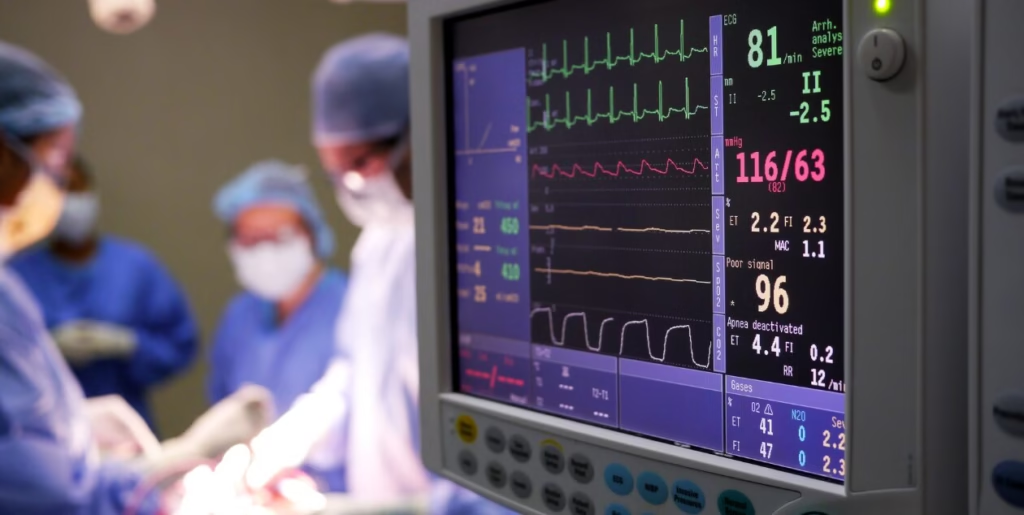
A Detailed Guide to Medical Facilities
This guide provides an in-depth look into various types of medical facilities using key terminology and roles relevant to healthcare environments. Each highlighted term is written in bold for clarity.
1. Types of Medical Facilities
- Hospital
A hospital is a comprehensive healthcare institution where patients receive round-the-clock medical care, including emergency treatment, surgical procedures, and inpatient services.
Example:
“He was taken to the hospital after the accident.” - Clinic
A clinic is a smaller facility focused primarily on outpatient care, preventive services, and minor treatments.
Example:
“She visits the clinic for her regular check-up.” - Nursing Home
A nursing home (sometimes called a long-term care facility) provides medical care and daily living support for elderly or chronically ill individuals.
Example:
“My grandmother lives in a nursing home.” - Urgent Care Center
An urgent care center is designed for immediate, non-life-threatening medical needs when a regular physician is unavailable.
Example:
“He went to the urgent care center after cutting his hand.”
2. Key Departments within Medical Facilities
- Emergency Department (ED)
The Emergency Department handles acute illnesses and severe injuries requiring immediate medical attention.
Example:
“The patient was admitted to the emergency department.” - Internal Medicine
Internal Medicine covers a broad range of adult diseases, managing chronic and complex conditions.
Example:
“She went to the internal medicine department for a check-up.” - Cardiology
The cardiology department focuses on the diagnosis and treatment of heart and vascular diseases.
Example:
“He works in the cardiology department.” - Radiology
Radiology specializes in diagnostic imaging (such as X-rays, CT, and MRI scans) to support accurate medical assessments.
Example:
“The doctor ordered a CT scan in radiology.” - Pediatrics
Pediatrics addresses the health needs of infants, children, and adolescents.
Example:
“She is a pediatrics nurse.” - Oncology
The oncology department is devoted to cancer diagnosis, treatment, and ongoing management.
Example:
“He was referred to oncology for further treatment.” - Anesthesiology
Anesthesiology manages patient comfort and vital functions before, during, and after surgical procedures.
Example:
“Anesthesiology ensures the patient does not feel pain during the operation.” - Rehabilitation
Rehabilitation helps patients regain abilities lost due to injury, surgery, or illness.
Example:
“Patients regain mobility through rehabilitation.” - Pathology
Pathology is responsible for analyzing tissues and fluids to provide definitive medical diagnoses.
Example:
“The diagnosis was confirmed in the pathology lab.”
3. Essential Healthcare Roles in Medical Facilities
- Doctor / Physician
A doctor or physician leads diagnosis, prescribes treatment, and coordinates care across departments.
Example:
“The doctor examined the patient’s chest.” - Nurse
A nurse delivers direct care, monitors patient status, and supports both doctors and patients.
Example:
“Nurses monitor patients’ vital signs.” - Medical Assistant
Medical assistants support both administrative and clinical tasks, such as scheduling or basic procedures.
Example:
“The medical assistant helped schedule appointments.” - Surgeon
A surgeon is a physician specialized in performing operations.
Example:
“The surgeon performed a successful operation.” - Radiologic Technologist
This professional conducts medical imaging examinations in radiology.
Example:
“The radiologic technologist took an X-ray of the patient’s leg.” - Clinical Laboratory Technologist
A clinical laboratory technologist performs laboratory tests that support diagnosis and treatment.
Example:
“A technologist analyzed blood samples in the laboratory.”
4. Support Specialties and Allied Health Workers
- Medical Interpreter
A medical interpreter helps non-native speakers communicate with healthcare providers.
Example:
“The medical interpreter translated the doctor’s explanation for the patient.” - Prosthetist and Orthotist
The prosthetist and orthotist designs and fits devices such as artificial limbs and orthopedic braces.
Example:
“The prosthetist and orthotist made a custom leg brace for the patient.” - Orthoptist
An orthoptist helps diagnose and train patients with eye movement disorders.
Example:
“The orthoptist provided exercises for the child’s lazy eye.” - Health Information Manager
The health information manager maintains and secures patient records throughout the facility.
Example:
“The health information manager ensures that medical records are accurate and secure.”
5. Navigating a Medical Facility: Sample Process
- Reception
Upon arrival, patients are greeted by a receptionist or may interact with a health information manager for intake. - Consultation
Patients are directed to the appropriate department, such as internal medicine, based on symptoms. - Examination
A doctor or specialist (e.g., in pediatrics or cardiology) conducts an assessment.
If necessary, the patient may be referred to radiology or another department for specific tests. - Treatment & Support
Care may involve collaboration among nurses, technologists, and specialized staff, with support from medical interpreters as needed. - Discharge & Follow-Up
Discharge planning is often overseen by a medical social worker, with referrals to rehabilitation, home health nurses, or other services as required.
6. Table: Common Medical Facility Departments and Roles
| Facility/Department | Key Role/Staff | Example Sentence |
|---|---|---|
| Hospital | Nurse | “The nurse gave me an injection at the hospital.” |
| Radiology | Radiologic Technologist | “The radiologic technologist took an X-ray.” |
| Rehabilitation | Physical Therapist | “A physical therapist helped me to walk again.” |
| Oncology | Doctor / Nurse | “The doctor from oncology discussed treatment options.” |
This guide offers a foundation for understanding medical facilities, departments, and professional roles, useful for both patients and staff in international healthcare settings.
医療施設に関する詳細ガイド
このガイドでは、さまざまな種類の医療施設について詳細に解説します。
医療現場でよく使われる専門用語や職種名は、明確にするため太字で表記しています。
1. 医療施設の種類
- Hospital(病院)
病院は、24時間体制で診療・手術・入院などが行われる包括的な医療機関です。
例文:
“He was taken to the hospital after the accident.”
「彼は事故のあと、病院に運ばれました。」 - Clinic(クリニック)
クリニックは規模の小さい医療施設で、主に外来や予防的な診療、小規模な治療を提供します。
例文:
“She visits the clinic for her regular check-up.”
「彼女は定期健診のためにクリニックを訪れています。」 - Nursing Home(介護施設 / 老人ホーム)
介護施設または老人ホームでは、高齢者や慢性疾患をもつ人々への医療と生活支援が提供されます。
例文:
“My grandmother lives in a nursing home.”
「私の祖母は老人ホームに住んでいます。」 - Urgent Care Center(救急外来センター)
救急外来や急患センターは、応急処置が必要だが命に関わらないような症状に対応します。
例文:
“He went to the urgent care center after cutting his hand.”
「彼は手を切って救急外来センターに行きました。」
2. 主要な診療科・部門
- Emergency Department (ED)(救急外来)
救急外来では、重篤な怪我や急病などの緊急事態に24時間体制で対応します。
例文:
“The patient was admitted to the emergency department.”
「その患者は救急外来に搬送されました。」 - Internal Medicine(内科)
内科は成人を対象に、慢性疾患から日常の体調不良まで広く管理します。
例文:
“She went to the internal medicine department for a check-up.”
「彼女は健康診断のために内科を受診しました。」 - Cardiology(循環器内科)
循環器内科では、心臓および血管の病気(高血圧・心筋梗塞など)を診療します。
例文:
“He works in the cardiology department.”
「彼は循環器内科で働いています。」 - Radiology(放射線科)
放射線科では、エックス線、CT、MRIなどの画像を使った診断を行います。
例文:
“The doctor ordered a CT scan in radiology.”
「医師は放射線科でCT検査を依頼しました。」 - Pediatrics(小児科)
小児科は、乳児から思春期までの子どもを対象とした診療科です。
例文:
“She is a pediatrics nurse.”
「彼女は小児科の看護師です。」 - Oncology(腫瘍内科 / がん診療科)
腫瘍内科(腫瘍学)では、がんの診断、治療、経過観察を専門に行います。
例文:
“He was referred to oncology for further treatment.”
「彼はさらなる治療のため腫瘍内科に紹介されました。」 - Anesthesiology(麻酔科)
麻酔科は手術時の麻酔、術中管理、術後の痛みの管理などを担当します。
例文:
“Anesthesiology ensures the patient does not feel pain during the operation.”
「麻酔科は手術中の痛みを感じないように患者を管理します。」 - Rehabilitation(リハビリテーション科)
リハビリテーション科は、手術や事故、病気のあとに機能を回復させるための治療と運動訓練を行います。
例文:
“Patients regain mobility through rehabilitation.”
「患者はリハビリテーションを通じて身体機能を取り戻します。」 - Pathology(病理診断科)
病理診断科では、組織や体液の検査によって病気の最終診断を行います。
例文:
“The diagnosis was confirmed in the pathology lab.”
「診断は病理診断科の検査で確定されました。」
3. 医療施設における主要職種
- Doctor / Physician(医師)
医師は患者の診断、治療計画、検査の指示、処方などを総合的に行います。
例文:
“The doctor examined the patient’s chest.”
「医師が患者の胸を診察しました。」 - Nurse(看護師)
看護師は日々のケア、点滴・投薬、状態チェックなど多岐にわたる支援を行います。
例文:
“Nurses monitor patients’ vital signs.”
「看護師は患者のバイタルサインを管理しています。」 - Medical Assistant(医療助手)
医療助手は、受付・問診・簡単な医療処置など、医師や看護師のサポートを行います。
例文:
“The medical assistant helped schedule appointments.”
「医療助手が予約の調整を手伝いました。」 - Surgeon(外科医)
外科医は外科手術を担当する専門医です。
例文:
“The surgeon performed a successful operation.”
「外科医が手術を無事に成功させました。」 - Radiologic Technologist(診療放射線技師)
診療放射線技師はレントゲン・CT・MRIなどの画像処理と撮影を担当します。
例文:
“The radiologic technologist took an X-ray of the patient’s leg.”
「技師が患者の脚のレントゲンを撮影しました。」 - Clinical Laboratory Technologist(臨床検査技師)
臨床検査技師は血液、尿などの検体検査を行い、診断を支援します。
例文:
“A technologist analyzed blood samples in the laboratory.”
「臨床検査技師が血液検体を分析しました。」
4. 医療専門職・支援職(アライドヘルス)
- Medical Interpreter(医療通訳)
医療通訳は、多言語間の橋渡しをし、医師と外国人患者の間の意思疎通を助けます。
例文:
“The medical interpreter translated the doctor’s explanation for the patient.”
「医療通訳が医師の説明を患者に通訳しました。」 - Prosthetist and Orthotist(義肢装具士)
義肢装具士は切断された四肢の代替装具(義足・義手)や補助具の作成・調整を行います。
例文:
“The prosthetist and orthotist made a custom leg brace for the patient.”
「義肢装具士が患者に合わせた脚の装具を作りました。」 - Orthoptist(視能訓練士)
視能訓練士は斜視・弱視の訓練、視力や両眼視機能の測定を専門に行います。
例文:
“The orthoptist provided exercises for the child’s lazy eye.”
「視能訓練士が子どもの弱視矯正の訓練を行いました。」 - Health Information Manager(診療情報管理士)
診療情報管理士は、電子カルテや診療記録の管理・安全性維持を担当します。
例文:
“The health information manager ensures that medical records are accurate and secure.”
「診療情報管理士は医療記録が正確で安全であるように管理します。」
5. 医療施設の利用フロー(例)
- 受付:
患者は来院時に受付スタッフや診療情報管理士と最初に接触します。 - 診察:
症状に応じて内科や小児科、循環器科などへ案内されます。 - 検査:
必要に応じて、放射線科や検査部門が画像や血液検査を行います。 - 治療・支援:
医師、看護師、技師により治療が行われ、医療通訳やソーシャルワーカーが支えます。 - 退院・連携:
退院後はリハビリ科や訪問医療との連携、または緩和ケアに移行することもあります。
6. 医療施設の部門とスタッフ:例文一覧
| 部門/施設 | スタッフ | 例文 |
|---|---|---|
| Hospital | Nurse(看護師) | “The nurse gave me an injection at the hospital.” |
| Radiology | Radiologic Technologist | “The radiologic technologist took an X-ray.” |
| Rehabilitation | Physical Therapist | “A physical therapist helped me to walk again.” |
| Oncology | Doctor / Nurse | “The doctor from oncology discussed treatment options.” |
このガイドは、国際的な医療環境で重要な施設・診療科・役職などを理解しやすくまとめたもので、
患者・医療関係者のどちらにも役立つ構成になっています。
まとめ
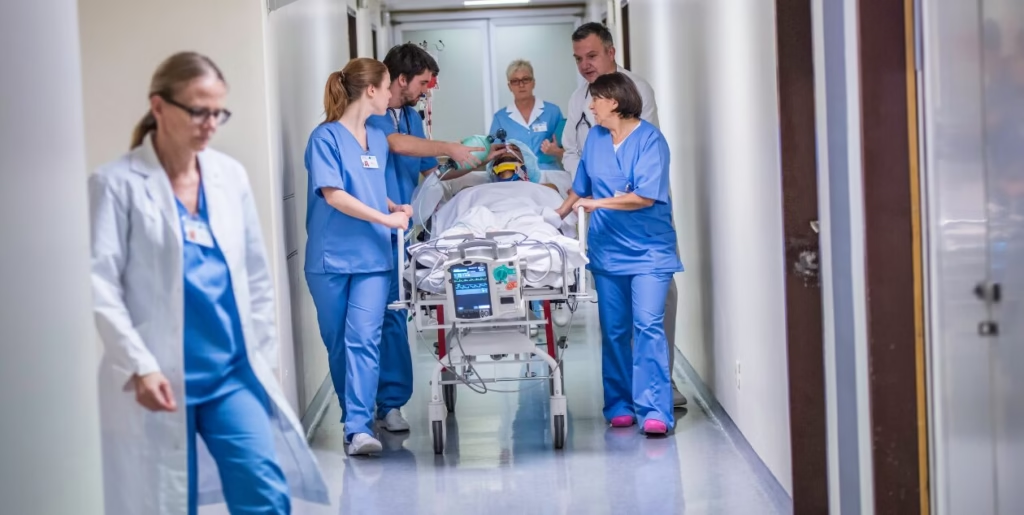
この記事では、国際的な医療環境を理解するために不可欠な医療施設の種類、主要な診療科・部門、そしてそこで働く様々な職種について、英語表現を交えながら詳しく解説しました。病院(Hospital)からクリニック(Clinic)、そして介護施設(Nursing Home)や救急外来センター(Urgent Care Center)といった施設の特性を理解し、緊急時や日常の受診で役立つ知識を深められたのではないでしょうか。
また、Emergency Department(救急外来)やInternal Medicine(内科)、Oncology(腫瘍内科)といった専門性の高い診療科、さらにはDoctor(医師)、Nurse(看護師)といった主要職種に加え、Medical Interpreter(医療通訳)やProsthetist and Orthotist(義肢装具士)のような専門的な支援職についても学びました。それぞれの役割と英語名を知ることで、海外の医療チームの構成や連携がより明確になったかと思います。
今回のガイドが、あなたが国際的な医療環境で自信を持ってコミュニケーションを取り、適切な医療サービスを受けるための羅針盤となることを願っています。いざという時に困らないよう、これらの知識をぜひ活用してください。
英語・英会話の基礎を学びたい方はこちらから! ↓

語彙力強化したい方はこちらから! ↓















